| Abbreviations: | Weights and measures: |
| dl = decilitre l = litre tsp = teaspoon tbsp = tablespoon g = grams |
1 kilogram = 1000 g = 2 lbs 3 oz 100 g = 3.5 oz 1 litre = 10 dl = (more than) 2 pints 1 decilitre = (less than) ½ cup |
Salads

Rosolli salad (Rosolli)
- 4 boiled potatoes
- 4 boiled carrots
- 4 boiled beetroot or pickled beetroot
- 1 gherkin
- 1 small onion
- salt, white pepper
Dressing:
- 1 1/2 dl cream
- 1 1/2 tsp vinegar (10%)
- 1 1/2 tsp sugar
(and the water the beetroot was cooked in)
Cook the vegetables in their skin well beforehand until just tender. Peel the vegetables and onion, and cut them into small, equal-sized cubes. Mix them together and season with a little salt and white pepper.
Whip the cream lightly, season with sugar and vinegar and add a few drops of beetroot liquid for colour. Serve the dressing separately. Garnish the salad with hard-boiled eggs, the yolks and whites chopped separately and laid in stripes on the top.
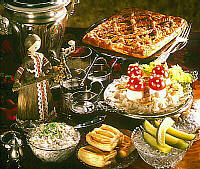
Finnish mushroom salad (Suomalainen sienisalaatti)
- 3–4 dl of salted mushrooms
- 1 onion
Dressing:
- 2 dl cream
- 1–2 tsp lemon juice or vinegar
- 1/2 tsp of sugar
- dash of freshly ground white pepper
Soak the salted mushrooms until the salt level is right. Press the excess water out and chop the mushrooms. Peel and chop the onion. Check the taste, it should have a slightly sharp tang. Stir the mushrooms and the chopped onions into the dressing.
The traditional Finnish mushroom salad is made of salted milk caps. Before salting, the cleaned mushrooms are boiled in plenty of water for five minutes, rinsed and cooled. Then the mushrooms are placed with layers of salt (salt content is 10–15% of the weight of the mushrooms) in glass jars. The mushrooms are pressed down into the jar by covering them with a weight, e.g. a plate with a clean stone on it, and stored in a cold place.
Breads and cheeses
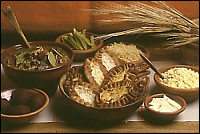
Karelian pasties (Karjalanpiirakat)
Ingredients:
- 1 decilitre water
- ½–1 tsp salt
- 2.5 decilitre rye flour
Rice filling:
- 2.5 decilitre water
- 1 litre milk
- 2.5 decilitre rice
- 1 tsp salt
- Rinse the rice and place it in boiling water. Simmer until most of the water is absorbed.Add the milk, lower the heat to a minimum, and partially cover the pot. Simmer until the milk has been absorbed and the rice has turned into a thick porridge. Season with salt and leave to cool.
- Add the flour and salt to the water and mix into a solid, compact dough.
- Form the dough into a strip and divide into 12 pieces.
- Roll the pieces into flat thin ovals.
- Spread some filling on each oval. Then fold the sides towards the center, pinching and making neat pleats along the edge.
- Bake at 300 ºC for about 10 minutes.
- Brush them well with melted butter or a butter and water mixture.
- Place the pasties, separated with baking paper, in a bowl and cover with a towel to soften the crusts.
- Serve warm with butter or egg butter which is made by mixing equal parts of butter, (cottage cheese) and chopped hard-boiled egg.
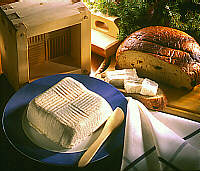
Egg cheese (Munajuusto)
- 3 l milk
- 1 l sour milk
- 4 eggs
- 1 tsp salt
Bring the milk almost to boiling point. Combine the eggs and sour milk and add to the hot milk, stirring gently. Continue to cook the milk over low heat, stirring until it curdles. Remove the saucepan from the stove and let the whey separate in a warm place for half an hour. Using a slotted spoon, transfer the curds to a sieve lined with muslin. Lightly press the whey out. Add the salt, stirring in well. Place a light weight on the cheese and leave it to stand in a cold place overnight.
Next day, turn the cheese onto an ovenproof dish. Brush the cheese with egg and bake at 250 °C until nicely brown.
Main courses
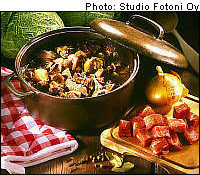
Karelian Hot Pot (Karjalanpaisti)
(serves 4–5 people)
- 300 g chuck steak
- 300 g pork shoulder
- 300 g stewing lamb or mutton
- 2–3 onions
- 1.5 tsp salt
- 8 allspice
- water
Cut the meat into cubes (4×4 cm). There is no need to remove small bones. Put the meat and coarsely chopped onion in layers in a casserole, seasoning each layer with salt and allspice. Add enough water to almost cover the meat.
Bake without a cover at a moderate temperature, c. 175 °C, for 2.5 to 3 hours. Cover the casserole towards the end of the cooking time.
Serve with mashed potato, boiled swedes and lingonberry purée.
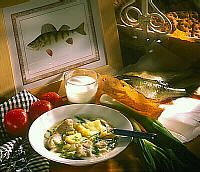
Fish soup (Kalakeitto)
(serves 4–5 people)
- 1 kg fish
- 1 l water
- 1 tsp salt
- 1 onion
- 10 allspice (whole)
- dill stems
- 1/2 leek
- 4 large potatoes
- 4 dl milk
- 1 tbsp flour
- dill and chives
Clean and fillet the fish. Boil the bones with coarsely chopped onion and spices. Cook for about 20 minutes. Strain the liquid into another saucepan. When the liquid comes to the boil, add the leek cut into rings and the peeled, diced potatoes. Cook for about 15 minutes. Cut the fish into chunks and add to the soup. Cook for another five minutes. Mix the flour with milk and add to the soup. Let the soup simmer for a few more minutes. Sprinkle plenty of chopped dill and chives on top of the soup.
If you want to use ready filleted fish, you will need 300–400 g. Add a fish bouillon cube to the liquid.

Fish soup à la Kainuu (Kainuulainen kalakeitto)
- 1–1.5 l water or good fish stock
- 1–2 onions
- 5–6 allspice berries
- (salt)
- 4–5 potatoes
- about 1/2 kg of filleted fish
- (salmon, whitefish, pike, perch)
- dill, chives, chopped parsley
Served with: melted butter chopped raw onions
Peel the onions and split them in pieces. Place them in the water or fish stock together with the allspice berries and bring to the boil. Cook for a while for the stock to become tasty. Peel the potatoes and cut into small pieces the size of your fingertips. Also cut the fish fillets into small cubes. Remove the onions and allspice berries from the stock and add the potatoes to cook. Let the soup boil for about ten minutes. Then add the fish and continue to cook for a few minutes until the fish is done. Chop the herbs and add to the soup. Serve the soup with melted butter and chopped raw onions, which every eater can add to the soup according to taste. The soup is at its best when eaten with rye bread.
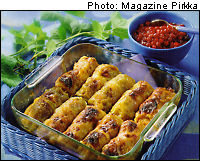
Cabbage Rolls (Kaalikääryleet)
(serves 4–5 people)
- 1 large white cabbage
- water, salted at 1 tsp per litre
Filling:
- 400 g of lean minced pork or beef
- 1 onion
- 1 dl cabbage cooking liquid
- 2 dl chopped cabbage
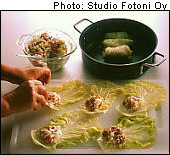
- 2 dl boiled rice
- 1 tsp salt
- 1/4 tsp white pepper
- 1 tsp marjoram
Topping:
- 1–2 tbsp syrup
- butter or margarine
- Cabbage cooking water for basting
Gravy:
- 3 dl pan juice
- 2 tbsp flour
- a little cream
Cut the stalk off the cabbage and cook the cabbage in salted water until the leaves are soft. You can carefully loosen the outer leaves as they soften. Lift the cooked cabbage onto a large plate to drain. Loosen the leaves one by one and chop the small inner leaves for the filling.
Finely chop the onion and fry in small amount of oil until translucent but not brown. Combine the meat, rice, chopped cabbage and seasonings into a smooth mixture. If the mixture is too thick, add some more of the cabbage cooking water.
Flatten the cabbage leaves. Lift a good tablespoonful of filling onto the leaf and roll it up tucking the edges round the mixture.
Place the rolls side by side in a baking dish, pour syrup and a little fat over them.
Bake the rolls for 1 hour at 200 °C. Half way turn the rolls over and baste them every now and then with the cabbage water.
Strain the pan juices and thicken with flour mixed with water. Add a little cream.
Serve the cabbage rolls with boiled potatoes and lingonberry purée.
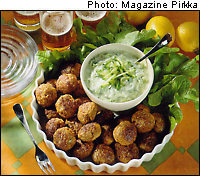
Meatballs (Lihapullat)
(serves 4–5 people)
- 500 g minced beef
- 1 dl fine dry breadcrumbs or two slices of white bread
- 1 dl cream
- 1 onion
- 1 tbsp oil
- 1 egg
- 1 tsp salt
- 1/4 tsp allspice or white pepper
Gravy:
- 2 tbsp fat
- 2 tbsp flour
- 4 dl pan juices
Mix breadcrumbs with water and cream in a bowl. Let stand for a while. Finely chop the onion and sauté in oil in a frying pan or microwave oven. Add the onion, egg, seasonings and meat. Mix until smooth. Wet your hands and shape the mixture into balls. Fry meatballs in hot fat on all sides. Small meatballs will be done in 3–5 minutes, larger ones 5–8 minutes.
To make gravy, brown the flour lightly in fat. Add the liquid stirring all the time. Add the cream and check seasonings. The gravy can be served separately or poured over the meatballs. Serve with potatoes and grated carrots. Lingonberry jam and gherkins also go well with the dish.
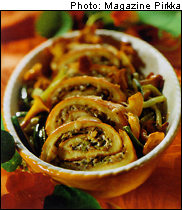
Mushroom-omelette roll (Sienimunakas-kääryle)
Omelette batter:
- 6 eggs
- 5 dl milk
- 1 dl wheat flour
- 1 tsp salt
- 1/2 tsp white pepper
Filling:
- 3 tbsp butter, margarine or cooking oil
- 1 l chantarelles, hedgehog mushrooms, ceps
- 2–3 onions, salt, black pepper
- basil or thyme
- (a little cream or crème fraiche)
On top:
- grated cheese
Preheat the oven to 200° C. To prepare the batter, first mix the flour in the milk. Beat the eggs in a separate bowl and add to the flour and milk mixture. Spice with salt and white pepper. Line a high-edged baking plate with greaseproof paper and pour the omelette batter on the paper. Bake in the oven until light brown. Overturn the omelette on another piece of greaseproof paper and remove the paper from the bottom. Chop the onions for the filling. Fry the chopped mushrooms in hot oil, add the onions and let cook until the liquid has nearly evaporated. Spice with salt and pepper, and, if you like, basil or thyme. (In case you prefer the filling to be more saucelike, add a little cream to the mixture and let cook for a while). Check the taste. Spread the mixture on the omelette and roll the sheet up. Carefully move the roll on a greased ovenproof plate and sprinkle grated cheese on top. Heat the omelette roll in 200° C before serving.
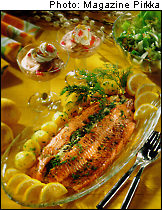
Cheese-and-herbs stuffed salmon (Yrttijuustolla täytetty lohi)
Ingredients:
- 1 kg salmon fillet
- black and lemon pepper
- salt
- lemon juice
Stuffing:
- unripened cheese
- dill, chives and thyme
Season the fish fillet with salt and black and lemon peppers to taste. Using a sharp knife, cut a less than one centimeter deep opening in the middle of the fillet from head to tail. Place the knife in the opening and cut a pocket to both sides of the opening. Unfold the pockets and spread the cheese in. Sprinkle finely chopped dill, chives and thyme on the cheese. Turn the upper side of each pocket on the cheese and herbs. Secure the opening with cocktail sticks some 5 cm apart. Sprinkle with lemon juice.
Bake in 200° C for about 20–25 minutes. When the fish is done, remove the sticks.
Serve with boiled potatoes and green salad.
Desserts
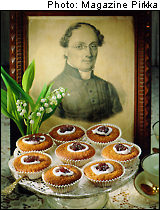
Runeberg cakes (Runebergin tortut)
(serves 4–5 people)
Ingredients:
- 200 g margarine or butter
- 2 dl sugar
- 2 eggs
- 2 dl wheat flour
- 1 tsp baking powder
- 1 tsp ground cardamom
- 2 dl sweet bread crumbs (e.g. crumbled biscuits)
- 2 dl ground almonds (appr. 80 g)
- 1 dl single cream
- solid raspberry jam
To moisten:
- 2 dl water
- 1 dl sugar
- 2–3 tbsp arrack liqueur or rum
Topping:
- solid raspberry jam or marmelade
Icing:
- 1 dl icing sugar
- 2 tsp water or lemon juice
Preheat the oven to 200°C.
Grind the almonds and combine them with the bread crumbs. Cream the butter or margarine and sugar together. Add one egg at a time, beating the mixture well after each egg. Combine the flour and baking powder and stir into the mixture.
Add the cardemom, bread crumbs and almonds and finally the cream. Mix lightly but do not unnecessarily stir the mixture. Grease a muffin mould and put a equal amount of the mixture into the hollows. Leave room for the mixture to raise in the hollows. Using a floured fingertip, press a hole in the middle of each muffin. Place about half a teaspoonful of jam or marmelade on each muffin. Bake in the middle of the oven for about 15 minutes.
Boil the water and melt the sugar in it. Flavour with the alcohol. Moisten the baked muffins with the liquid. When the muffins are still hot, add another half a teaspoonful of jam in the middle. Let the muffins cool.
Combine the icing sugar and water or lemon juice in a small bowl. Pour the liquid icing around the jam.
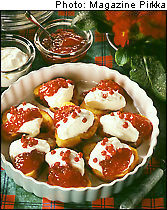
Poor knights (Köyhät ritarit)
- 1 slice of French bread or coffee bread per person
- 1 egg
- 3 dl milk
- pinch of salt
For frying:
- butter or margarine
On top:
- lingonberry jam (and whipped cream)
1. Cut a thick slice of bread for each person
2. Whip the egg and mix in milk and a pinch of salt
3. Dip the slices in the milk and egg mixture
4. Fry until golden brown on both sides
5. Serve hot topped with a bit of lingonberry jam. If you top it all off with whipped cream, your “poor knights” become “rich knights”.
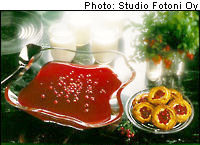
Lingonberry Delight (Marjakiisseli)
- 1 l diluted, sweetened berry juice
- 4 tbsp cornflour
- 2–3 dl fresh or frozen lingonberries
Place the berries in a serving dish. Put the cornflour and cold juice into a saucepan and bring to the boil, stirring the whole time. Remove the saucepan from the heat and pour the thickened juice over the berries. Sprinkle a little sugar on top. Serve with milk. Bilberries and strawberries or redcurrants and raspberries can also be used.
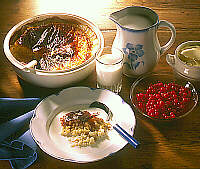
Oven porridge (Uunipuuro)
- 2.5 dl pearl barley
- 0.5 l water
- 1.5 l milk
- 1 tsp salt
Combine all the ingredients in a buttered oven dish.
Bake the porridge for 4–5 hours at 125 °C. Also whole oats, wheat, rice, buckwheat or millet make excellent porridge. Serve the porridge with milk or fruit sauce.
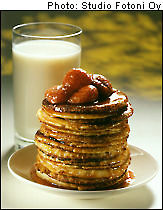
Pancakes (Ohukaiset)
- 0.5 l milk or 2.5 dl cream and 2.5 dl water or mineral water
- 1.5 dl flour
- 2 eggs
- about 1 tsp salt
1. Mix the flour and the milk. Add the salt and beat in the eggs. Let the batter stand for a minute before frying.
2. Fry pancakes on a hot pan, greased with butter or margarine.
3. Serve with sweet jam.
To make a sheet pancake from the same batter, pour into a greased baking pan or frying pan and bake in the oven at 225° C until golden brown.
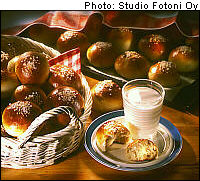
Sweet Buns (Pikkupullat)
- 5 dl milk
- 50 g yeast
- 1 egg
- 1.5 dl sugar
- 1 tsp salt
- 1 tbsp cardamom
- about 1 kg plain flour
- 100–150 g margarine or butter
Heat the milk until lukewarm. Dissolve the yeast in a bowl with the warm milk. Stir in egg, sugar, salt and cardemom. Add enough flour to make a thick mixture and beat until shiny.
Add the rest of the flour to the dough and knead by hand. Leave some of the flour for shaping the buns and continue to work the dough until smooth and elastic. Add the softened fat and knead the dough until it comes off your hands and the edges of the bowl. Cover the bowl with a towel and leave in a warm draught-free place until double in bulk. Then put it on a floured board and shape it into small round buns. Brush the risen buns with beaten egg and sprinkle with sugar.
Bake the buns at 225 °C for 8–10 minutes. Let cool covered with a towel.
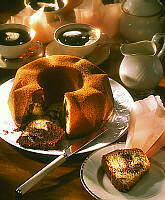
Tiger cake (Tiikerikakku)
- 200 g margarine
- 2 dl sugar
- 3 eggs
- 3 dl flour
- 2 tsp vanilla sugar
- 2 tsp baking powder
- 3 tbsp milk
- 2–3 tbsp cocoa
Carefully butter and flour a cake tin. Beat fat and sugar until light and fluffy. Add eggs one at a time, beating thoroughly after each one. Add the baking powder and vanilla sugar to the flour and stir in slowly. Put one-third of the mixture in another bowl and add 2–3 tbsp of sifted cocoa and 3 tbsp of milk.
Put the mixture into the prepared cake in tin in layers, beginning and ending with the plain mixture. Bake at 175 °C for 50–60 minutes or until a skewer inserted in the centre comes out clean.
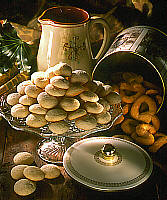
Aunt Hanna’s biscuits (Hanna-tädin piparkakut)
- 150 g melted butter or margarine
- 3 dl sugar
- 3 dl cornflour
- 4 dl plain flour
- 1.5 dl (sour) cream
- 1 tsp soda
Mix all ingredients together and leave until firm. Shape the dough into long rolls. Cut the rolls into pieces of equal size and form into small balls. Bake at 200 °C until golden.
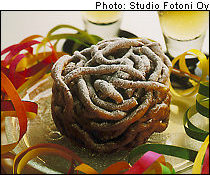
May Day Cookies (Tippaleivät)
- 2 eggs
- 2 tsp sugar
- 1 tsp salt
- 2 dl milk
- 4 dl flour
- ½ tsp vanillin
To fry:
- vegetable or coconut oil
Mix the eggs and sugar, but don’t beat! Add the other ingredients and stir into a smooth batter.
Put the batter into a paper cone or a pastry bag fitted with a small-holed nozzle.
Squeeze the batter in a thin band into the hot oil. Use a spiral motion to form nest-like cookies. If possible, use a metal ring in the pot to keep the cookies in shape.
When the cookies have turned golden brown, remove and drain them on paper towels.
Dust the cold cookies with powdered sugar.
Drinks
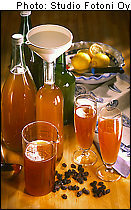
Mead (Sima)
- 5 l water
- 350 g sugar
- 350 g brown sugar
- 2 lemons
- tiny bit of yeast
Wash the lemons and peel them thinly. Remove the pith. Slice the lemons and place them with the peel and sugar in a sufficiently large vessel.
Bring half of the water to the boil and pour it over the lemons, peel and sugar. Stir and leave to stand covered for a while. Add the rest of the water cold. When the liquid is lukewarm add the yeast.
Keep the mead at room temperature until it starts to ferment, i.e. about one day. Put a couple of raisins and 1 tsp of sugar into clean bottles, and strain the mead into the bottles. Loosely cork the bottles and store them in a cool place. The mead is ready when the raisins rise to the surface.
Photos by Studio Fotoni (except main photo)



